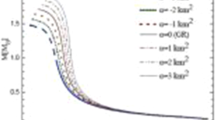Abstract
Following the general formalism presented by Rezzolla, Ahmedov and Miller,(1) we here derive analytic solutions of the electromagnetic fields equations in the internal and external background spacetime of a slowly rotating highly conducting magnetized neutron star. The star is assumed to be isolated and in vacuum, with a dipolar magnetic field not aligned with the axis of rotation. Our results indicate that the electromagnetic fields of a slowly rotating neutron star are modified by general relativistic effects arising from both the monopolar and the dipolar parts of the gravitational field. The results presented here differ from the ones discussed by Rezzolla, Ahmedov and Miller(1) mainly in that we here consider the interior magnetic field to be dipolar with the same radial dependence as the external one. While this assumption might not be a realistic one, it should be seen as the application of our formalism to a case often discussed in the literature.
Similar content being viewed by others
REFERENCES
L. Rezzolla, B. J. Ahmedov, and J. C. Miller, “General relativistic electromagnetic fields of a slowly rotating magnetized neutron star. I. Formulation of the equations,” Mon. Not. R. Astr. Soc. 322, 723 (2001).
V. L. Ginzburg and L. M. Ozernoy, “On gravitational collapse of magnetic stars,” Zh. Eksp. Teor. Fiz. 47, 1030–1040 (1964).
J. L. Anderson and J. M. Cohen, “Gravitational collapse of magnetic neutron stars,” Astrophys. Space Science 9, 146–152 (1970).
J. A. Petterson, “Magnetic field of a current loop around a Schwarzschild black hole,” Phys. Rev. D 10, 3166–3170 (1974); “Stationary axisymmetric electromagnetic fields around a rotating black hole,” Phys. Rev. D 12, 2218–2225 (1975).
U. Geppert, D. Page, and T. Zannias, “Magnetic field decay in neutron stars. Analysis of general relativistic effects,” Phys. Rev. D 61, 123004 (2000).
A. Muslimov and A. I. Tsygan, “General relativistic potential drops above pulsar polar caps,” Mon. Not. R. Astr. Soc. 255, 61–70 (1992).
A. Muslimov and A. K. Harding, “Towards the quasi-steady state electrodynamics of a neutron star,” Astrophys. J. 485, 735–746 (1997).
K. Konno and Ya. Kojima, “General relativistic modification of a pulsar electromagnetic yield,” Prog. Theor. Phys. 104, 1117–1127 (2000).
J. B. Hartle, “Slowly rotating relativistic stars. I. Equations of structure,” Astrophys. J. 150, 1005–1029 (1967).
J. B. Hartle and K. S. Thorne, “Slowly rotating relativistic stars. II. Models for neutron stars and supermassive stars,” Astrophys. J. 153, 807–834 (1968).
L. D. Landau and E. M. Lifshitz, The Classical Theory of Fields (Pergamon, Oxford, 1971).
J. C. Miller, “Quasi-stationary gravitational collapse of slowly rotating bodies in general relativity,” Mon. Not. R. Astr. Soc. 179, 483–498 (1977).
S. Sengupta, “General relativistic effects on the induced electric field exterior to pulsars,” Astrophys. J. 449, 224–230 (1995).
S. Sengupta, “General relativistic effects on the ohmic decay of crustal magnetic fields,” Astrophys. J. 479, L133–L136 (1997).
B. J. Ahmedov, “General relativistic galvano-gravitomagnetic effect in current carrying conductors,” Phys. Lett. A 256, 9–14 (1999).
A. Lichnerowicz, Relativistic Hydrodynamics and Magnetohydrodynamics (Benjamin, New York, 1967).
G. F. R. Ellis, “Relativistic cosmology,'' in Cargese Lectures in Physics, Vol. 6, E. Schatzman, ed. (Gordon & Breach, 1973), pp. 1–60.
H. Stephani, General Relativity (University Press, Cambridge, 1990).
J. M. Bardeen, W. H. Press, and S. A. Teukolsky, “Rotating black holes: Locally non-rotating frames, Energy Extraction, and Scalar Synchrotron Radiation,” Astrophys. J. 178, 347–369 (1972).
A. J. Deutsch, “The electromagnetic field of an idealized star in rigid rotation in vacuo,” Ann. Astrophys. 1, 1–10 (1955).
A. Gupta, A. Mishra, H. Mishra, and A. R. Prasanna, “Rotating compact objects with magnetic fields,” Class. Quantum Grav. 15, 3131–3145 (1998).
A. R. Prasanna and A. Gupta, “Structure of external electromagnetic field around a slowly rotating compact object and charged-particle trajectories,” Nuovo Cimento B 112, 1089–1106 (1997).
A. Jeffrey, Handbook of Mathematical Formulas and Integrals (Academic, San Diego, 1995).
Author information
Authors and Affiliations
Rights and permissions
About this article
Cite this article
Rezzolla, L., Ahmedov, B.J. & Miller, J.C. Stationary Electromagnetic Fields of a Slowly Rotating Magnetized Neutron Star in General Relativity. Foundations of Physics 31, 1051–1065 (2001). https://doi.org/10.1023/A:1017574223222
Issue Date:
DOI: https://doi.org/10.1023/A:1017574223222




